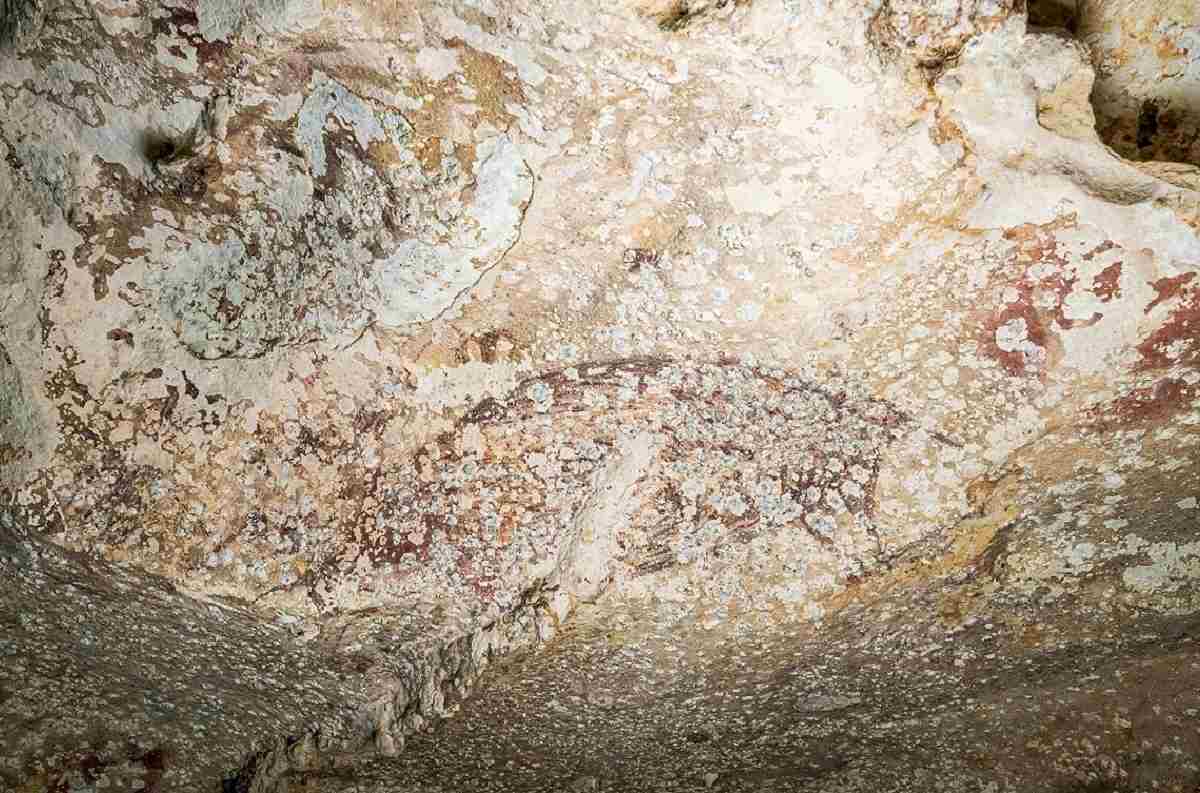
A painting created at least 51,200 years ago in the limestone cave of Leang Karampuang in the Maros-Pangkep region of South Sulawesi Province, Indonesia, shows three human-like figures interacting with a wild pig, in this undated image.
12:57 JST, August 1, 2024
On the ceiling of a limestone cave on the Indonesian island of Sulawesi, scientists have discovered artwork depicting three human-like figures interacting with a wild pig in what they have determined is the world’s oldest-known confidently dated cave painting — created at least 51,200 years ago.
The researchers used a new scientific approach to determine the minimum age of the newly disclosed painting inside the Leang Karampuang cave in the Maros-Pangkep region of South Sulawesi Province by using a laser to date a type of crystal called calcium carbonate that formed naturally on top of the painting.
“The method is a significant improvement over other methods and should revolutionize rock art dating worldwide,” said Maxime Aubert, a specialist in archaeological science at Griffith University in Australia and one of the leaders of the research published on July 3 in the journal Nature.
The scene, dominated by a representation of a pig measuring 92 centimeters by 38 centimeters that is standing upright along with three smaller human-like figures, is painted in a single shade of dark red pigment. There are other images of pigs in the cave as well.
The researchers interpreted the painting as a narrative scene, which they said would make it the oldest-known evidence of storytelling in art.
“The three human-like figures and the pig figure were clearly not depicted in isolation in separate parts of the rock art panel,” said Griffith University archeologist Adam Brumm, another of the study leaders.
“Rather, the juxtaposition of the figures — how they are positioned in relation to each other — and the manner in which they are interacting were clearly deliberate, and it conveys an unmistakable sense of action. There is something happening between these figures. A story is being told. Obviously, we don’t know what that story was,” Brumm added.
The researchers used the same dating method to reassess the age of another Sulawesi cave painting from a site called Leang Bulu’ Sipong 4, also depicting a narrative scene, this time depicting apparent part-human, part-animal figures hunting pigs and dwarf buffalo. It turned out to be at least 48,000 years old, upward of 4,000 years earlier than previously thought.
“We, as humans, define ourselves as a species that tells stories, and these are the oldest evidence of us doing that,” Aubert said.
In the Leang Karampuang painting, the interaction between the human-like figures and the pig, a species still inhabiting the island, is somewhat cryptic.
“Two of these figures are holding objects of some kind, and at least one figure seems to be reaching toward the pig’s face. Another figure is positioned directly above the pig’s head in an upside down position,” Brumm said.
Little is known about the people who created the Sulawesi cave paintings. Aubert said the paintings may turn out to be older than the minimum age determined by the new testing and possibly date to the first Homo sapiens wave to sweep through the region, eventually reaching Australia about 65,000 years ago, on their migration out of Africa.
Until now, the oldest-known cave painting was one at Leang Tedongnge cave, also in Sulawesi, from at least 45,500 years ago.
The Leang Karampuang painting, the researchers said, predates the cave paintings of Europe, the earliest of which is at El Castillo in Spain, dating to about 40,800 years ago.
There is a hand stencil painting from Spain’s Maltravieso cave that some scientists have dated to around 64,000 years ago and attributed to Neanderthals. Other scientists have disputed the age of the painting and have argued that it was created by Homo sapiens.
“This discovery of very old cave art in Indonesia drives home the point that Europe was not the birthplace of cave art, as had long been assumed. It also suggests that storytelling was a much older part of human history, and the history of art in particular, than previously recognized,” Brumm said.
“The earliest Sulawesi rock art is not ‘simple,’” Aubert added. “It is quite advanced and shows the mental capacity of people at the time.”
"Science & Nature" POPULAR ARTICLE
-

Genome Study Reveals Milestone in History of Cat Domestication
-

Big Leap in Quest to Get to Bottom of Climate Ice Mystery
-

Security Camera Footage Vulnerable to Outside Access; Investigation Finds 3,000 Pieces Exposed Online
-

Japan Set to Participate in EU’s R&D Framework, Aims to Boost Cooperation in Tech, Energy
-

Paws on Parade: Nairobi’s Dogs Dazzle at ‘Pawchella’
JN ACCESS RANKING
-

Tokyo Economic Security Forum to Hold Inaugural Meeting Amid Tense Global Environment
-

Keidanren Chairman Yoshinobu Tsutsui Visits Kashiwazaki-Kariwa Nuclear Power Plant; Inspects New Emergency Safety System
-

Imports of Rare Earths from China Facing Delays, May Be Caused by Deterioration of Japan-China Relations
-

University of Tokyo Professor Discusses Japanese Economic Security in Interview Ahead of Forum
-

Japan Pulls out of Vietnam Nuclear Project, Complicating Hanoi’s Power Plans






















